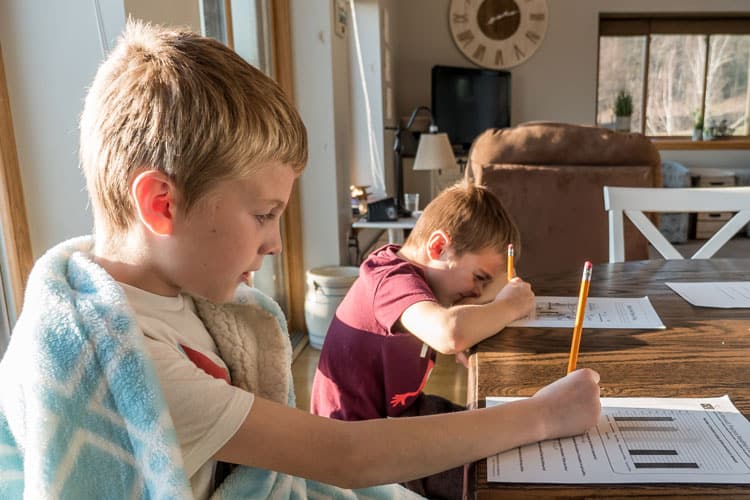Are you considering homeschooling your child and don’t know where to begin? Nowadays, homeschooling looks a lot differently than it used to and it may be worth exploring for families seeking an alternative learning environment.
People choose to homeschool for a million different reasons that are unique to each individual family and child. Some choose to homeschool for the freedom to travel while they learn, some due to medical reasons, and some for the benefit of learning at their own pace. If you have found yourself in the position of wondering how to start homeschooling and are interested to find out what it might look like for your child(ren), here is a brief overview of where to begin.
Before getting started, ask yourself these 3 important questions:

- Why do I want to homeschool my child? List the reasons beginning with your highest priority. These answers will help you form a framework for what your homeschool might look like as well as help make decisions regarding enrollment, curriculum, and scheduling.
- How does my child like to learn? (visual, auditory, and kinesthetic and tactile) Does your child need to move and touch things to understand them? Do they love to read books and soak up tons of information that way? Does your child narrate what they do and talk to themself? These are all indicators of the kind of learner you have! If you don’t know, don’t fret. There are ways to find out.
- How much time a day do I (as a parent) have available to focus on teaching? Whether you are a stay-at-home parent, working from home parent, single parent, parent with dozens of children; your life is unique to you and it’s important to be aware of the time you have available to dedicate to your child’s education.
Answer these questions thoughtfully and honestly. There are no right or wrong answers. You are just collecting information to help you get started. Knowing your child’s learning style as well as their strengths and weaknesses helps tremendously when deciding how to start homeschooling your child. Homeschooling multiple children in varying grades can seem daunting. But fear not! It can be done, and it can be wonderful.
Now that you’ve answered some important questions, here are the next steps to put those ideas into action.
Get to know your state’s legal requirements.

The HSLDA (Home School Legal Defense Association) website is a fantastic resource for families seeking support with how to start homeschooling. They have homeschool laws listed by state here. They list the different options to homeschool that each state allows. Some examples of different options to homeschool include: homeschooling as a home-based private school, homeschooling with a private school satellite program (PSP), homeschooling via instruction by a private tutor, etc.
Members can sign up and receive discounts on online classes, be informed of state requirements, provide college prep, etc. This is an essential resource for all families learning how to start homeschooling.
*Many public schools offer a homeschool or an independent study program. This is a great way to begin your homeschool journey while still having the assistance and support from a local school.
Homeschool Teaching Approaches

This is where knowing your child’s learning style coincides with how to start homeschooling. Just like every student is unique and learns differently, every family’s homeschool approach looks differently as well.
There are a variety of teaching approaches or philosophies that allow families to tailor their child’s learning experience to best fit them as an individual. For example, if you have a student that absolutely loves rich literature and fine art, they may be keen to a Charlotte Mason approach which uses living books, not textbooks, for their studies. Montessori families have self-directed activity, hands-on learning and collaborative play. Unschoolers learn through their natural life experiences including play, household responsibilities, personal interests and curiosity, internships and work experience, travel, books, elective classes, family, mentors, and social interaction.
There are dozens of different homeschool approaches, such as; traditional, classical, eclectic, unit studies, and more. To learn more about your child’s learning style and homeschool philosophies for teaching, check out these two quizzes by Eclectic Homeschool.
Related articles:
- How to Incorporate the Montessori Method at Home
- How To Prepare Your Child For Kindergarten
- How to Help Your Child With Back-to-School Anxiety
- Best Subscription Boxes for Babies & Toddlers
Choosing Your Curriculum

Once you’ve honed in on your teaching philosophy and your child’s learning style, THEN you can begin your search for the curriculum that best fits your family. Searching for curriculum can be daunting when trying to figure out how to start homeschooling. It’s a great idea to join homeschool groups either online or in your community. Find other families that you can ask questions and learn from. Find out what they use, if there are local meetups, learning centers, etc.
Do you have a child that loves graphic novel style books like Diary of a Wimpy Kid? There’s a curriculum called Beast Academy which is a comprehensive full math curriculum for grades 2 thru 5, drawn in an engaging comic-book style! Whether you are interested in pulling resources from various curricula for each subject, or if you’re looking for a curriculum that includes multiple subjects; such as Moving Beyond the Page, you can always go on Cathy Duffy Reviews or Youtube and see other people’s reviews of a certain curriculum. They will often walk you through the pros and cons of using specific ones and give organizational tips. If you took the quizzes posted above, you can search curricula based on those results.
If you choose to homeschool through a public school, you will be assigned a teacher that will assist you with curriculum, scheduling, attendance, as well as offer you tons of support.
Planning & Scheduling

There are different levels of planning that you can do. If your teaching method requires a lot of prep ahead of time, you need to plan accordingly. Most curricula will already have some kind of pacing guide or lesson plan for you to either follow or get an idea from. Then it just becomes a matter of creating a schedule and knowing what needs to be prepped and when. Put it all on a calendar to stay organized.
You can do a broad semester plan which will outline lesson numbers & topics. This will be the framework for you to add to little by little. This is more of a “plan of what to plan”.
Now, this is where a lot of people start to feel overwhelmed and second guess whether or not homeschooling is for them. The planning process looks different for each person and only needs to be as thorough as you want it to be. It does not need to be a big event or an exhaustive act. This planning process should be flexible and will vary vastly depending on your teaching philosophy.
Useful Tips for How to Start Homeschooling

- Create a routine: When learning how to start homeschooling, routine creates stability. I’ll say it again, routine creates stability. This will also eliminate a lot of complaining and the kids will then keep you, the parent, on track! Even though one of the beautiful things about homeschooling is its freedom and flexibility of schedule, there is power in creating a routine at home. It doesn’t have to be rigid, but starting off each day the same way and setting expectations of work to be done, will do you and your child a lot of good.
- You don’t have to teach every subject: If you really don’t like teaching a certain subject, your kids aren’t going to like it either. If you don’t want to teach art, for example, send them to an art class. Same thing for other subjects. Team up with other homeschool families and create a co-op.
- Take an online class: There are so many awesome online classes available. You can choose to do all their schooling online, or just choose a class or two. This option is fantastic for families with parents juggling working, multiple children, or just need a break from teaching! Check out Outschool, Khan Academy, Accelus, Time4Learning, K12, Liberty University, IXL.
- Find a group to join: There are so many facebook groups for homeschooling families. If you are using a specific curriculum or follow a teaching method, there is a group for it! There are Charlotte Mason homeschoolers, Montessori moms, Secular homeschoolers, Exploring Nature with children curriculum, Time4Learning homeschoolers, Unschoolers!, WorldSchooling, etc. There are many, many groups. The point is, find your people!
- Give yourself grace: Figuring out how to start homeschooling your child can be overwhelming even to those that are most qualified. Why? Because your child’s education is important to you and no one is going to care about your child’s education more than you. So give yourself the grace to figure it out and don’t do it alone!
If you homeschool your children, share your favorite curriculum in the comments! If you are just getting started, hopefully a lot of your questions were answered here and you have a better idea of how to start homeschooling your child. If not, ask us below!!

Juliana is a BabyQuip Quality Provider in Truckee, CA. and is excited to provide quality service to families visiting Lake Tahoe and surrounding areas! Pack light and rent all the baby’s necessities and more while you travel. She is a homeschooling mother of 3 and enjoys traveling, hiking, reading, and coffee!



Before reading this, I thought the only option for homeschooling was online classes. Thanks for the tips and resources, cant wait to explore some!
Such great information! Gives me a great starting point and heading in the right direction for when we start this process for this next school year!
So helpful, especially these days!